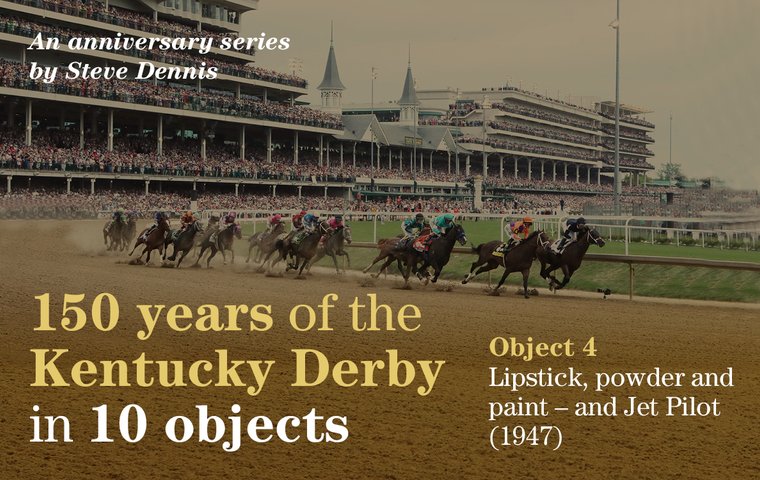
In the latest instalment of his series celebrating the 150th anniversary of America’s greatest race, Steve Dennis recalls how mercurial celebrity owner Elizabeth Arden took centre stage at Churchill Downs in the 1947 edition
Before they race, horses get the beauty treatment. Coats are brushed, manes are plaited, hooves are oiled.
Once upon a time, though, certain horses – including a Kentucky Derby winner – were given a little extra help to make them look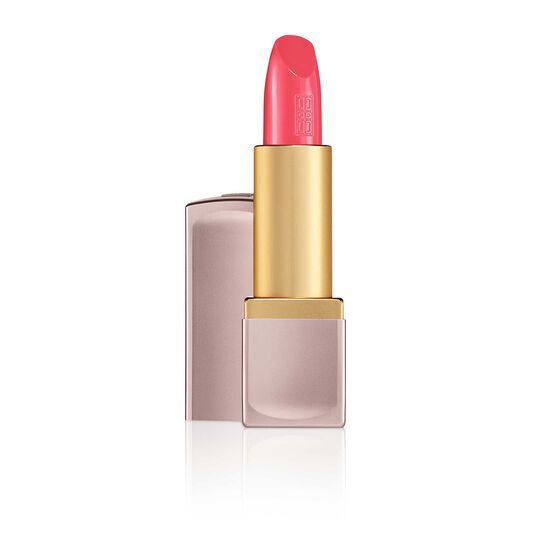 good, feel good, a wholly unconventional approach from a thoroughly unconventional owner who did the same for millions and millions of women.
good, feel good, a wholly unconventional approach from a thoroughly unconventional owner who did the same for millions and millions of women.
Elizabeth Arden was not a beauty queen but she was the queen of beauty, building a cosmetics empire that literally changed the face(s) of the world.
When Arden – whose given name was the slightly unlikely Florence Nightingale Graham, and in a textbook case of nominative determinism studied nursing before going into business – opened her first salon in New York in 1910, the use of lipstick, powder and paint was either an indication of loose morals or the oldest profession.
Arden adopted the name of her all-conquering brand and by the time she bought her first racehorse in 1931, she had developed an operation that brought in millions of dollars a year from products that were used by women all around the world – and, as has been mentioned, certain horses.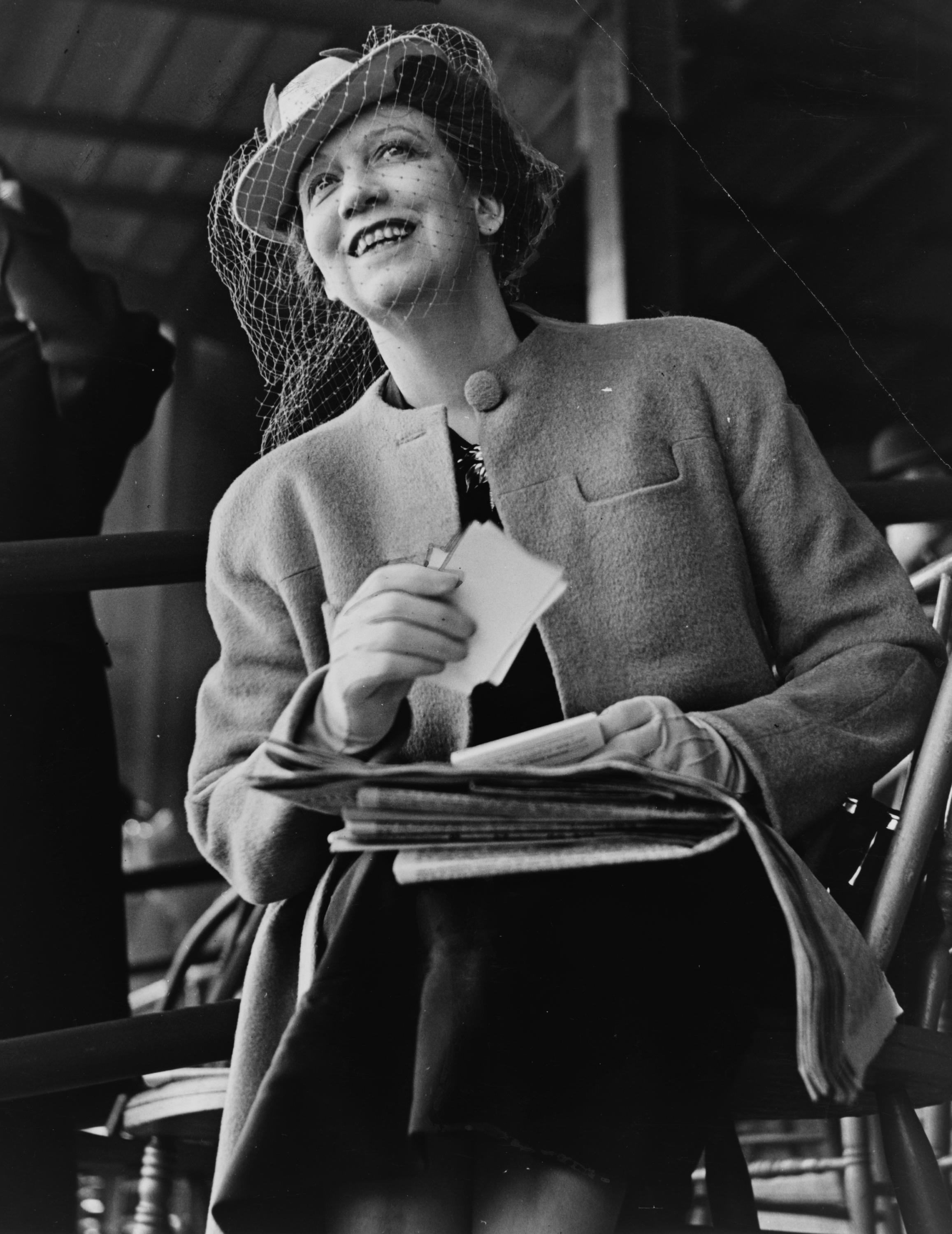
Arden never had children; her horses were her babies. It was said that she dispensed with the services of her first trainer, Clarence Buxton, because he treated her horses like horses.
‘A beautiful horse is like a beautiful woman’
Arden called them her ‘darlings’ and treated them like Upper East Side socialites. “A beautiful horse is like a beautiful woman,” she said, and believed what was good for one was just as good for the other.
Her darlings could not go to the beauty parlour so she brought it to them, insisting that their stalls be screened to keep the flies away, massaging their sore knees and shins with her own fair hands, developing products to aid her horses that were just as effective for people too.
She produced a special Ardena lotion to soothe the eyes of her babies, and preferred them to be sluiced with her skin tonic rather than horse liniment as she hated the smell. Moreover, she regarded her world-famous Eight-Hour Cream as just the thing to rub into her horses’ legs after a workout. It was apparently very good for cracked heels.
Such eccentricities were applied across the board in Arden’s racing empire. She went through trainers and jockeys like showgirls went through her lipstick; more than 60 trainers were swept aside by Arden’s well-meant whirlwind of dainty devotion – the record-breaker lasted no more than four hours.
Her demands were manifold and arcane. One trainer was fired for chewing tobacco. She telephoned Ivan Parke in the middle of the night because she had dreamed that one of her fillies was stuck up a tree outside the barn. She asked Parke to go and c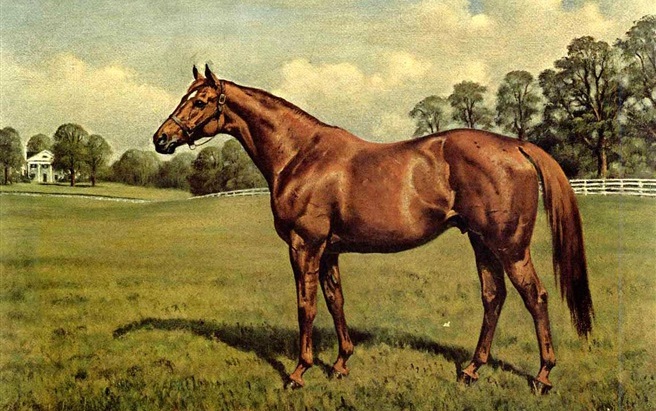 heck. He did, reporting with admirable restraint that it wasn’t so.
heck. He did, reporting with admirable restraint that it wasn’t so.
“Every time I hear a stable boy speak roughly to one of my fillies I want to pitchfork him,” she told the Daily Racing Form. She fired jockeys for whipping her horses and, in the interests of fairness, got rid of another for not trying hard enough.
‘Her horse was always the best’
“One of the lady’s problems was the fact that if she lost a race, she couldn’t understand that her horse was not good enough. Her horse, in her eyes, was always the best,” sighed the exasperated all-time great Eddie ‘Banana Nose’ Arcaro, who once lost the ride on one of Arden’s horses because she dreamed the night before that he had been beaten in the race.
People saw madness in the methods but no-one could argue with the results. Arden – under the banner of Maine Chance Farm, named for her beauty spa – was leading owner in 1945, and her cerise silks with a white sash and blue cuffs were carried that year by two-year-old champions Star Pilot and Beaugay, both trained by Tom Smith, who had chaperoned the career of the immortal Seabiscuit.
‘Silent Tom’ Smith, who doled out his words with the reluctance of a bookmaker peeling off tenners at pay-out time, surprisingly got on very well with Arden. “I try not to hurt her feelings, yet still do it my way,” he said, a marathon oration for the great man.
In 1947, Smith sent Arden’s colt Jet Pilot to Churchill Downs as 5-1 second-choice in a field of 13 for the Kentucky Derby, fresh and well off a two-race campaign including victory in the six-furlong Jamaica Handicap and no doubt lavishly anointed with his owner’s proprietary make-up magic.
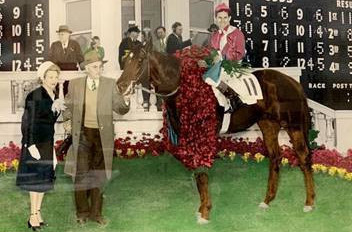 The Derby favourite was Wood Memorial winner Phalanx, ridden by the aforementioned Arcaro; his owner CV Whitney had evidently enjoyed a dreamless sleep on Derby eve.
The Derby favourite was Wood Memorial winner Phalanx, ridden by the aforementioned Arcaro; his owner CV Whitney had evidently enjoyed a dreamless sleep on Derby eve.
‘Get out in front and go, go, go!’
Arden was an advocate of front-running, frequently delivering tactical advice to her jockeys with the directive ‘get out in front and go, go, go!’ That was how it went for Jet Pilot, who broke on top from his outside post under 22-year-old Eric Guerin and towed the field along over a muddy track designated as ‘slow’.
While Jet Pilot and Guerin were ‘go-go-going’, Arcaro and Doug Dodson aboard the well-fancied Faultless were playing cat-and-mouse, both jockeys convinced they had only the other to beat. Such a dilatory approach allowed Jet Pilot to hold a two-length advantage at the eighth-pole, and although Arcaro and Dodson finally began to ride for their lives they had left it too late.
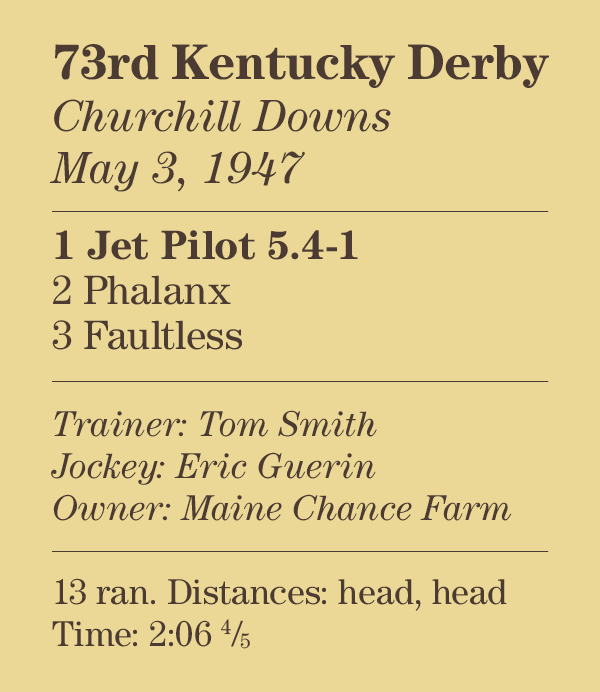 Guerin, mindful of Arden’s strict views on the subject, never used his whip but merely waved it in his mount’s peripheral vision, and Jet Pilot gamely held off the posse to beat Phalanx by a head, with Faultless third by the same margin. The time was a leisurely 2:06⅘; no Derby winner since then has covered the distance so slowly.
Guerin, mindful of Arden’s strict views on the subject, never used his whip but merely waved it in his mount’s peripheral vision, and Jet Pilot gamely held off the posse to beat Phalanx by a head, with Faultless third by the same margin. The time was a leisurely 2:06⅘; no Derby winner since then has covered the distance so slowly.
It was a race for the history books, the first Kentucky Derby to be decided by the photo-finish print. Perhaps it was inevitable that Jet Pilot would look his best for the camera; that’s what the art of Elizabeth Arden was all about.
• Visit the Kentucky Derby website and the Kentucky Derby Museum website
View the latest TRC Global Rankings for horses / jockeys / trainers / sires


